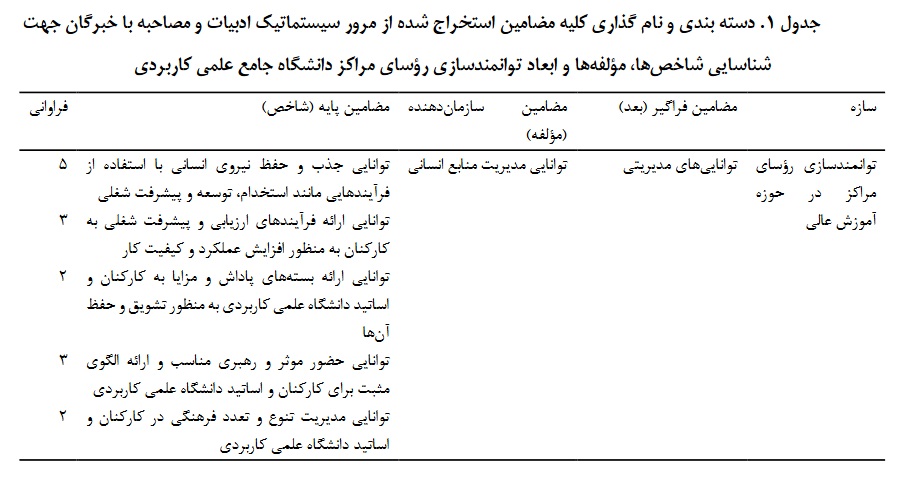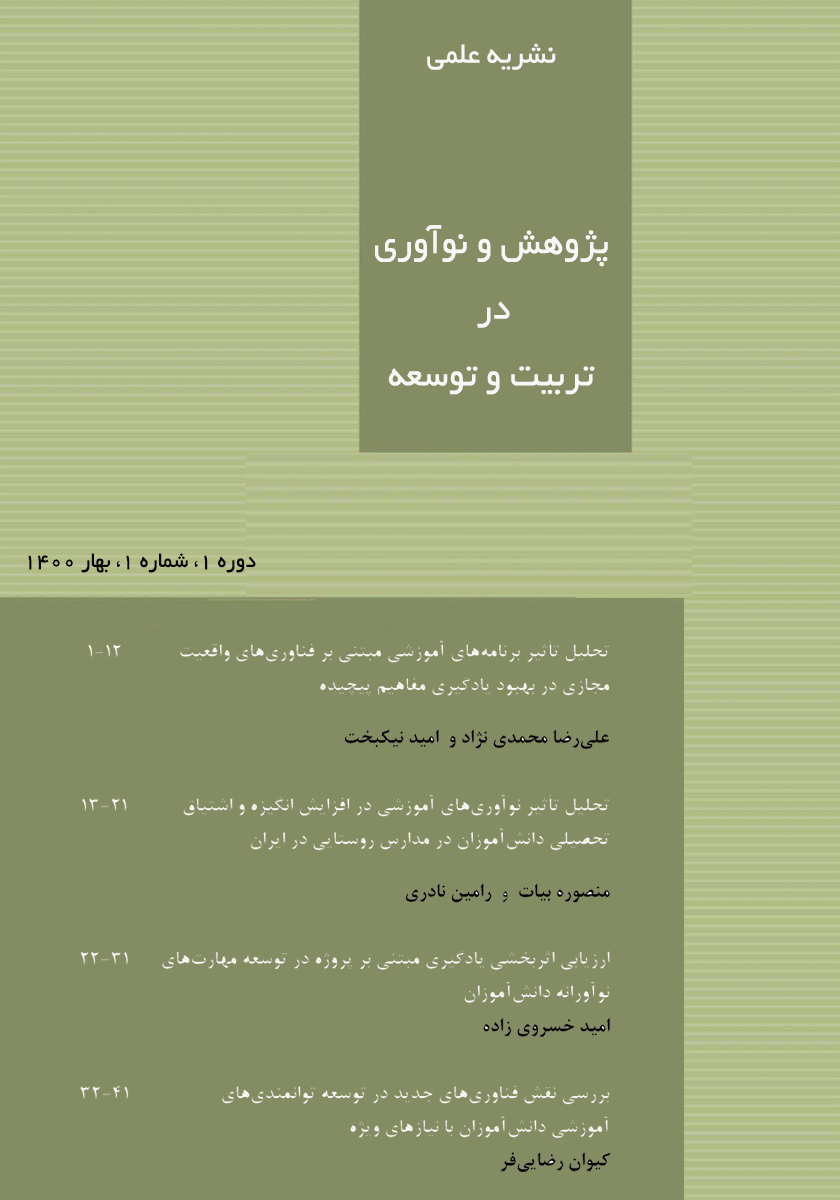Identification of Indicators, Components, and Dimensions of Empowerment of Heads of Comprehensive Applied Science University Centers
Keywords:
managerial abilities, personal abilities, educational quality improvementAbstract
The present study aimed to identify the indicators, components, and dimensions of empowerment of the heads of centers of the Comprehensive Applied Science University. The research, in terms of purpose, was applied, and in terms of data type, it was a meta-synthesis and content analysis of interview texts. The study population included theoretical foundations and related literature from domestic databases (2012-2022) and international databases (2013-2023), as well as experts and specialists from the Comprehensive Applied Science University. The sample size was determined by systematic elimination based on the PRISMA model flowchart, and the content analysis section included 13 interviewees selected through purposive sampling and based on the principle of saturation. The data collection tools were library documents and semi-structured interviews with experts. To calculate the validity, a 27-item checklist based on the PRISMA model was used, and for reliability, Cohen's kappa coefficient method was applied for the meta-synthesis section, along with content validity, retest reliability, and inter-coder agreement. The data analysis method was thematic analysis (basic, comprehensive, and organizing themes) using Maxqda2020 software. The findings revealed that the dimensions of empowerment for heads of centers in higher education include managerial abilities (with components such as human resource management ability with 5 indicators, financial management ability with 5 indicators, research and development management ability with 4 indicators, and information technology management ability with 4 indicators), communication abilities (with components such as active listening ability with 6 indicators, effective speaking ability with 5 indicators, ability to communicate with others with 4 indicators, ability to use various communication methods with 5 indicators, and negotiation and conflict resolution ability with 4 indicators), professional abilities (with components such as mastery of current knowledge and technologies with 5 indicators, ability to plan and manage educational courses with 4 indicators, ability to develop relationships with industry with 4 indicators, ability to enhance organizational culture with 5 indicators, and ability to manage transformations with 5 indicators), and personal abilities (with components such as communication ability with 4 indicators, technical ability with 5 indicators, leadership ability with 5 indicators, and educational ability with 6 indicators).
Downloads
References
Rashidi Z. Scholarship of Teaching, missing Function of higher education in Iran; Reflection of Bullying. 2020.
Habibi A, Beheshti Far M, Kazemi H. Identification and Qualitative Analysis of Challenges in Higher Education in
Iran. Iranian Political Sociology. 2022;5(11):6346-68.
Sherick HM. The thoughtful development of others: A qualitative study of the impact of developmental relationships
on chief academic officers in higher education2014.
Hemmati MA, Qasemzadeh A. The Role of Knowledge Creation and Its Dimensions in Management Skills of
Managers of Tabriz University of Medical Sciences. Depiction of Health. 2016;6(3):16-23.
Sprafke N, editor Dynamic capabilities and job design: Applying employee empowerment to organizational renewal.
EGOS Colloquium conference; 2013; Edinburgh, UK.
Haile A. Leadership Styles at Haramaya University and Implications for Corporate Success. East African Journal of
Sciences. 2017;11(1):51-8.
Yamani Dozi Sorkhabi M. Examining the state of development planning of public universities in Iran. Quarterly
Journal of the Iranian Higher Education Association. 2009;4(1):1-19.
Ngai EW, Chau DC, Chan T. Information technology, operational, and management competencies for supply chain
agility: Findings from case studies. The Journal of Strategic Information Systems. 2011;20(3):232-49. doi:
1016/j.jsis.2010.11.002.
Kurzhals K. Resource recombination in firms from a dynamic capability perspective: Coventry University and
Münster University; 2015.
Torkzadeh JM, Salimi M, Forough QB. Academic Empowerment with a Strategic Approach: a Situational Framework
for Planning the Development of Bamiyan University, Afghanistan. Quarterly Journal of Educational Planning Studies.
;6(11):133-57.
Elgamel M. Dynamic organizational capabilities: the joint effect of agility, resilience and empowerment. Journal of
Human Resource Management. 2018;6(2):44-9. doi: 10.11648/j.jhrm.20180602.11.
Abdollahi B, Nohe Ibrahim M. Employee Empowerment: The Golden Key of Human Resources Management.
Tehran: Virayesh Publications; 2007.
Salari S, Abedini M. Examining the role of management succession planning (MSP) in talent identification and
empowerment of human capital in Hormozgan University of Medical Sciences. Hormozgan Medical Journal. 2017;21(2):119-
doi: 10.29252/hmj.21.2.119.
Mirzamahdi MH, Mohammadi H. A Reflection on the Anthropological Foundations of "Quality Assessment" in
Iranian Higher Education and Its Alignment with Islamic Anthropology. Journal of Measurement and Educational Evaluation
Studies. 2020;32:167-202.
Marks TA, Jorns BA. Challenges with the self-consistent implementation of closure models for anomalous electron
transport in fluid simulations of Hall thrusters. Plasma Sources Science and Technology. 2023;32(4):045016. doi:
1088/1361-6595/accd18.
Akter KM, Tang SM, Adnan Z. Impact of empowerment and ICT on quality of work life: The mediating effect of
trust climate. Cogent Business & Management. 2023;10(1). doi: 10.1080/23311975.2023.2176412.
Dhanabhakyam M, Rekha R. An empirical study on employee empowerment in banks during demonetization period
with reference to select banks in Coimbatore District. International Journal of Advanced Educational Research. 2017;6:281-4.
Duan Y, Chen Y, Liu S, Wong CS, Yang M, Mu C. The moderating effect of leadership empowerment on relational
capital and firms' innovation performance in the entrepreneurial ecosystem: Evidence from China. Journal of Intellectual
Capital. 2023;24(1):306-36. doi: 10.1108/JIC-07-2021-0183.
Türkmendağ Z, Tuna M. Empowering leadership and knowledge management: the mediating role of followers'
technology use. Journal of Organizational Change Management. 2022;35(2):330-47. doi: 10.1108/JOCM-11-2020-0364.
Kang MM, Park S, Sorensen LC. Empowering the frontline: internal and external organizational antecedents of teacher
empowerment. Public Management Review. 2022;24(11):1705-26. doi: 10.1080/14719037.2021.1919185.
Kumar N, Liu Z, Jin Y. Evaluation of employee empowerment on taking charge behaviour: an application of perceived
organizational support as a moderator. Psychology Research and Behavior Management. 2022:1055-66. doi:
2147/PRBM.S355326.
Aldaihani SG. Administrative empowerment among Kuwait University staff and its effect on their job satisfaction.
Journal of Applied Research in Higher Education. 2020;12(2):210-29. doi: 10.1108/JARHE-02-2019-0027.
Ekowati VM, Sabran S, Supriyanto AS, Pratiwi VU, Masyhuri M. Assessing the impact of empowerment on achieving
employee performance mediating role of information communication technology. Quality-Access to Success.
;22(184):211-6. doi: 10.47750/QAS/22.184.27.

Downloads
Published
Submitted
Revised
Accepted
Issue
Section
License
Copyright (c) 2024 Journal of Study and Innovation in Education and Development

This work is licensed under a Creative Commons Attribution-NonCommercial 4.0 International License.










